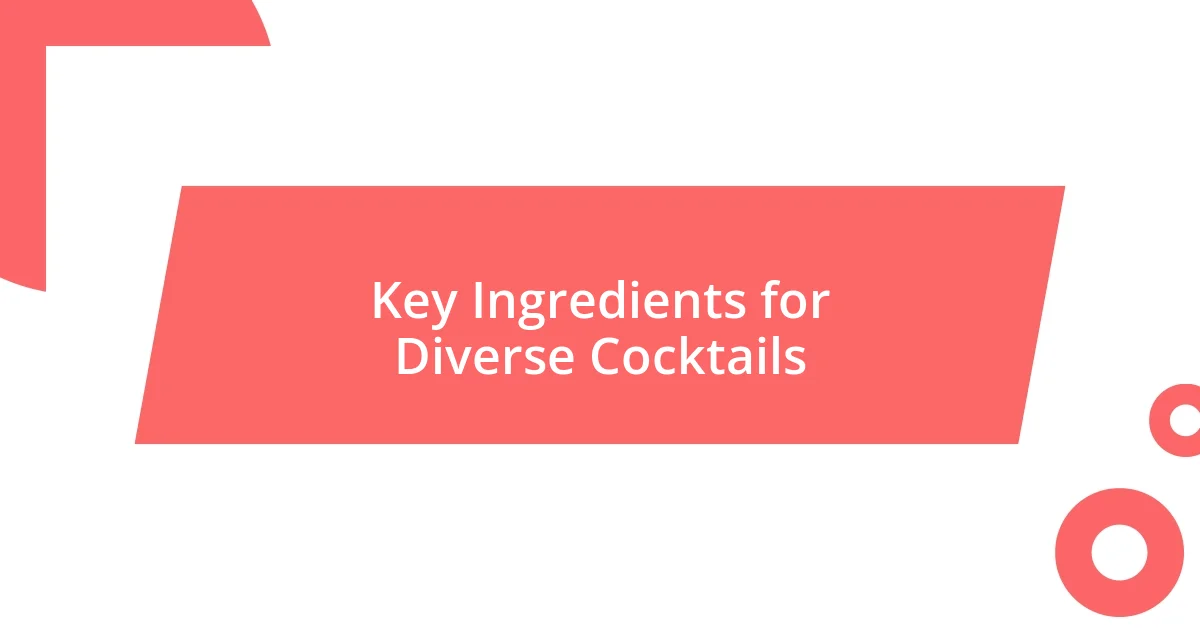Key takeaways:
- Multi-cultural cocktails are not just about flavors; they represent a blend of history, tradition, and emotion from various cultures.
- Key ingredients for diverse cocktails, such as soju, sake, and tropical fruits, enhance authenticity and evoke cultural memories.
- Techniques like infusion, muddling, and textural elements play a crucial role in crafting unique and flavorful cocktails.

Introduction to Multi-Cultural Cocktails
Multi-cultural cocktails are a delightful journey through diverse cultures, each sip telling a story of tradition and innovation. Recently, I found myself at a rooftop bar where the bartender expertly blended Korean soju with tropical fruits, creating a cocktail that was both refreshing and new. Have you ever experienced the thrill of trying a drink that transported you to another corner of the world?
Exploring different cultures through cocktails can be an exciting and eye-opening experience. I remember sipping a spicy Mexican margarita that was perfectly balanced with both heat and sweetness, reminding me of vibrant nights spent at local taquerias. The thrill lies not just in the flavors, but in how each drink can evoke memories and emotions from different parts of the globe.
As we delve deeper into multi-cultural cocktails, it’s fascinating to consider how these drinks are more than just a mix of ingredients—they’re a blend of history, artistry, and community. Ever wondered how a simple rum punch can connect you to Caribbean roots? I know I have, and each time, I discover a new layer of appreciation for these vibrant expressions of culture. In this exploration, we can truly celebrate the creativity and heritage each cocktail brings to the table.

Key Ingredients for Diverse Cocktails
The key ingredients that define diverse cocktails often reflect the unique flavors and traditions of their cultures. Personally, I find that playing with these ingredients not only enhances the drink’s authenticity but also enriches my own experiences. For instance, using cardamom in an Indian-inspired cocktail can infuse a warm, aromatic quality that reminds me of my favorite chai tea moments shared with friends.
Here are some essential ingredients you might consider for your own multicultural cocktail explorations:
- Soju: A Korean spirit known for its smoothness, perfect for light and fruity blends.
- Sake: Japanese rice wine that adds a delicate sweetness and umami flavor.
- Agave: The base for tequila, offering a complex, slightly earthy sweetness reminiscent of Mexican culture.
- Tamarind: A tangy ingredient found in many Latin flavors, bringing a unique sour note to drinks.
- Fresh Herbs: Like mint or cilantro, which provide freshness, drawing from Mediterranean or Middle Eastern influences.
- Fruits: Tropical fruits like mango and passionfruit can transport you to summer days in the Caribbean or Southeast Asia.
- Spices: A sprinkle of cayenne or paprika for an unexpected kick, reminiscent of flavors from North African cuisine.
Each ingredient tells its own story and evokes particular memories—like the time I mixed pineapple juice with rum and felt like I was lounging on a beach in Barbados, if only for a few minutes. The thrill lies in blending these flavors, much like the cultures they originate from, creating something truly unique in every glass.

Techniques for Crafting Unique Flavors
When it comes to crafting unique flavors in multi-cultural cocktails, technique is just as essential as the ingredients. I often find that infusing spirits with herbs or spices opens a whole new world of flavor possibilities. For instance, I recall a weekend when I tried steeping fresh rosemary in gin. The aroma was intoxicating, and the resulting cocktail had a beautiful complexity that transported me to a cozy Italian summer.
A fun method I love is muddling ingredients together. It allows the individual flavors to marry beautifully before they hit my glass. When I made a Thai basil mojito, I didn’t just slap the leaves—oh no! I gently pressed them with lime and sugar, letting that vibrant basil essence permeate the cocktail. That fresh vegetal note was a game-changer, transporting me to a bustling Bangkok market with every sip.
I’m also a sucker for textural elements in cocktails. Have you ever tried foam or aquafaba in a cocktail? It adds an unexpected creaminess, reminiscent of a light dessert. I experimented with a pisco sour using aquafaba instead of egg whites one evening. The texture was unbelievably smooth, and the resulting drink was like a fluffy cloud on my tongue, which is a delightful reminder of how creativity can elevate flavors beyond my expectations.
| Technique | Description |
|---|---|
| Infusion | Steeping herbs, spices, or fruits in spirits to enhance flavor. |
| Muddling | Gently crushing ingredients to release their essential oils and flavors. |
| Textural Elements | Incorporating foam or aquafaba for added creaminess and mouthfeel. |

My Favorite Multi-Cultural Cocktail Recipes
One of my all-time favorite multicultural cocktails is the Mango Basil Margarita. It beautifully combines fresh mango puree with a hint of basil, creating a balance between sweet and herbaceous that I simply can’t resist. I remember sitting on my patio one sunny afternoon, sipping this vibrant drink, and feeling like I was on a tropical getaway. The flavors whisked me away, reminding me of the lively streets of Mexico.
Another cocktail I adore is the Lychee Martini. The first time I tried it was at a trendy Asian fusion restaurant, and I was instantly captivated by its unique floral notes. Using fresh lychee not only lends a delicate sweetness but also a refreshing twist, different from traditional cocktails. I’ve experimented with adding a dash of elderflower liqueur, which enhances that floral essence, making each sip feel like an indulgence in a luxurious garden party.
The Spicy Tamarind Mule is another gem I’ve come to love. I stumbled upon this creation when experimenting with tamarind paste in cocktails, and wow, what a revelation! The kick of ginger beer mixed with tangy tamarind results in a playful interaction of flavors that ignites your palate. I recall hosting friends for a casual gathering; that cocktail stole the show and sparked conversations about its bold taste. It’s interesting how a drink can not only refresh but also create lasting memories, isn’t it?

Tools and Glassware for Serving
When it comes to serving multicultural cocktails, the right tools can make all the difference. I’ve learned that a quality cocktail shaker is essential for achieving that perfect blend. The first time I used a Boston shaker, I felt like a pro; it was so easy to mix my concoctions, and the result was flawless. Have you ever noticed how satisfying it feels to shake a drink and watch the ice dance around?
Glassware is another critical element to consider, as it can enhance the drinking experience. I particularly love serving cocktails in unique, culturally inspired glasses, like a delicate coupe for a French 75 or a sturdy ceramic mug for a spicy Mexican drink. Each piece tells a story and adds an extra touch of flair. I remember presenting a beautiful hibiscus cocktail in a hand-painted glass that instantly transported my guests to a vibrant beach bar in Mexico. It’s amazing how glassware can set the mood, don’t you think?
Lastly, don’t underestimate the power of garnishes and tools for presentation. I often use a zester to add citrus twists that brighten the drink visually and flavor-wise. A simple cocktail can transform into a showstopper with just a few fresh herbs or a vibrant fruit slice. One evening, while experimenting with a cucumber-infused gin, I elegantly draped thin cucumber ribbons over the edge of the glass, and my friends couldn’t stop raving about how picturesque it looked! I find it hard to believe that such little details can create such a big impact, but they truly do.















